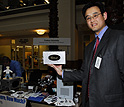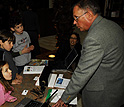|

Exhibit Descriptions

NSF FY 2008 Budget Open House
Featuring science and engineering exhibits
 |
February 5, 2007
11:00 A.M.-5:00 P.M.
|
Credit: Nicolle Rager Fuller, National Science Foundation
The full poster is here. (803 KB) |
See search-and-rescue robots in action ... find out if your dollar has a "criminal" past ... see a supercomputer in action ... plus 12 other exhibits, representing the broad range of research and education activities supported by NSF directorates and programs.
BIOLOGICAL SCIENCES (BIO)

 |
The Computable Plant: Modeling Plants and Plants as Models
Elliot Meyerowitz/University of California, Irvine (lead); California Institute of Technology; Huntington Library, Art Collections and Botanical Gardens; and Institute for Cytology and Genetics (Novosibirsk, Russia) |
Larger version, caption and credit, plus additional images
|
While plants are integral to our survival, we know little about what makes them tick. Researchers are creating a "computable plant" by coupling genetic data, mathematical models and laboratory studies to trace the cellular developments that lead to the formation of leaves and flowers. Through intensive, year-long programs, five cadres of high school teachers start to bridge the gap between the current science curriculum and this research, and they learn how plants can be used to train the next generation of scientists.

COMPUTER AND INFORMATION SCIENCE AND ENGINEERING (CISE)

Robots to the Rescue: With funding from NSF, small ground, air, and sea robots from the Center for Robot-Assisted Search and Rescue at the University of South Florida have been used in disasters such as the World Trade Center and Hurricane Katrina; this exhibit provides a hands-on introduction to these rescue robots and the multidisciplinary challenges they pose for computer and information science and engineering.

EDUCATION AND HUMAN RESOURCES (EHR)

Urban Cincinnati students assist a school in rural Tanzania by contributing sand filtration
equipment for water treatment. Students connect societal necessities with technology, while the
authentic experiences of a traveling graduate fellow enhance student learning.
In the RepTools project, we are using technology to support learning about complex systems. To accomplish this, we developed hypermedia and multiple computer simulations to foster middle school students' understanding of the human respiratory system and the aquarium ecosystem, which we will showcase in this exhibit. These instructional tools were used by over 300 middle school children, and the results showed great improvements in the students' understanding of how systems work.

ENGINEERING (ENG)

Our exhibit will feature a modular, extensible dynamic hexapod robot and its use in a novel NSF-funded freshman undergraduate engineering curriculum in which the students work on structured, but not scripted, engineering design problems. The aim is to develop the students' critical-thinking and problem-solving abilities.

GEOSCIENCES (GEO)

EarthScope is a bold undertaking--applying modern observational, analytical and telecommunications technologies in support of fundamental research on the structure and evolution of the North American continent, and the physical processes controlling earthquakes and volcanic eruptions. Supported by the NSF Major Research Equipment and Facilities Construction (MREFC) account through the Division of Earth Sciences, the project is installing arrays of thousands of instruments to sense ground motions across the United States and drilling a deep borehole across the San Andreas Fault in California. With the EarthScope facilities now more than halfway through their construction phase, exciting data and results are emerging and new integrative experimental programs are underway.

MATHEMATICAL AND PHYSICAL SCIENCES (MPS)

Ever since the launch of the "Star Trek" television series, the race has been on to build the "tricorder." We have built it and will demonstrate its use—on gaseous, liquid and solid samples. Our tricorder is actually a miniature mass spectrometer, small enough and light enough to be carried by hand and able to detect trace levels of contaminants in important applications like homeland security, monitoring pollutants, police work, fire-fighting and medicine.
This is a model of a magnetically levitated (or "maglev") train. The base of the train is made of the superconducting material YBCO. When this material is cooled below the superconducting transition temperature and held at a short height above the magnetic track, it "remembers" this height and will hover above the track until it warms up.
See Cosmic Rays in real time at NSF. A hand-held portable particle detector based on Scintillating Fiber Technology is used to detect and optically amplify the tracks of cosmic rays so that they can be seen by the naked eye or with a simple video camera. The very same device can also be used to reveal the interactions of a wide range of particles at accelerators such as the electromagnetic showers produced by a beam of electrons and the dramatic collisions created by beams of heavy ions.

POLAR PROGRAMS (OPP)

The Center for Remote Sensing of Ice Sheets will present an overview of its work to characterize rapidly-changing regions of the world's great ice sheets. The aim is to characterize the changes in these ice masses and predict the impact to the world's sea levels. Part of the display will include a scale model of the Meridian unmanned aerial vehicle (UAV), being developed and built at the University of Kansas as a next-generation ice radar-sensing platform with many potential spin-off applications.

SOCIAL, BEHAVIORAL AND ECONOMIC SCIENCES (SBE)

The development of vulnerability science--data, methods, tools--is in its infancy and is an exciting new perspective for understanding what makes people and places vulnerable to natural disasters and people's ability to respond to disasters. The interdisciplinary research supported by NSF has improved our ability to integrate social, behavioral and natural science data to help explain the geographic and temporal patterns of vulnerability. This exhibit shows some of the graphic outputs from this research.
Evolutionary anthropology is a very visual discipline, based on the detailed anatomy of fossils and modern comparative material, as well as evolutionary trees. Our research team (the NYCEP Morphometrics Group) analyzes the shapes of primate (e.g., monkey and human) skulls and skeletal bones to reconstruct evolutionary trees, visualize the skulls of hypothetical common ancestors of evolutionary sublineages, and distinguish between the bones of similar species and individuals. We use the statistical approach of 3-Dimensional geometric morphometrics (in which the relationships among bone shapes are retained in the analysis) combined with computer visualization and functional anatomy.

OFFICE OF INTERNATIONAL SCIENCE AND ENGINEERING (OISE)

The Office of International Science and Engineering (OISE) funds international research and education activities in all NSF supported disciplines in any region of the world. Howard University students participating in the East Asia and Pacific Summer Institutes, an Alaskan teacher just back from an Antarctic expedition, and an AAAS Fellow/Arctic researcher will highlight our role in developing the next generation of globally engaged scientists and engineers.

OFFICE OF CYBERINFRASTRUCTURE (OCI)

The National Center for Supercomputing Applications (NCSA) Advanced Visualization Laboratory team will present a sequence of 3-Dimensional scientific visualizations displayed in high-definition stereo using a VisBox™ display system. Participants will wear stereo glasses and view an F3 tornado, Monterey Bay oceanography, and a variety of astrophysics including a supernova and colliding galaxies. The NCSA visualization team works closely with computational scientists to visualize advanced large-scale supercomputing simulations for informal science education and outreach, in venues such as digital full-dome planetaria, and with programs shown on public broadcast television.

EXPERIMENTAL PROGRAM to STIMULATE COMPETITIVE RESEARCH (EPSCoR)

The University of Hawaii at Manoa has established a new Institute for Integrated Earth Observing Systems, and has assembled a "Technology Innovation Team" to develop a robust cyberinfrastructure prototype for use in "integrated earth observing systems" in the United States and beyond. We will focus on some of the unique biophysical features of island ecosystems, and on how Hawaii's amazing natural heritage has played an important role in science education in the state.
|



























